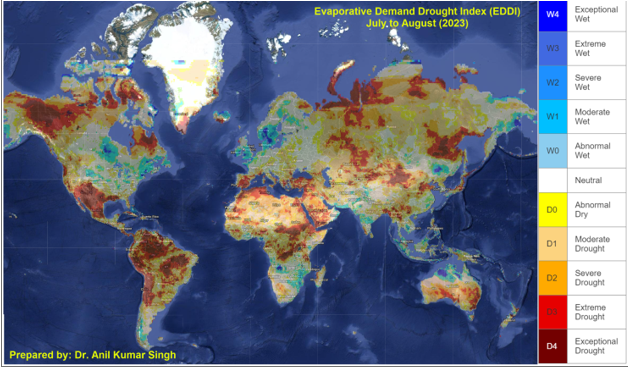
Introduction to the Evaporative Demand Drought Index (EDDI)
The Evaporative Demand Drought Index (EDDI) provides a unique perspective on drought assessment. Unlike traditional indices that rely solely on precipitation levels, EDDI captures the complex relationship between temperature, humidity, wind, and solar radiation. This holistic approach helps us understand drought in a more nuanced way, accounting for the atmospheric conditions that contribute to water loss from soil and vegetation.
Analysis of Current 2-Month EDDI Data
Our recent analysis of EDDI data spanning the last two months paints a concerning picture. Across the globe, around 60% of countries are grappling with severe drought, reflected in the high EDDI values recorded. From the arid regions of Africa to the parched landscapes of Australia, USA, Canada and some part of European countries, this data highlights the wide-reaching impact of drought on diverse ecosystems.
Impact on Society, Agriculture, Wildfires, and the Environment
Society: Severe droughts reverberate through society, triggering water scarcity that affects households, industries, and municipalities. The lack of accessible clean water jeopardizes hygiene, health, and human well-being. Moreover, water conflicts can arise, heightening geopolitical tensions and underscoring the interconnectedness of water security and global stability.
Agriculture: Agriculture is particularly vulnerable to drought. As soil moisture dwindles due to high evaporative demand, crops wither, and yields diminish. Food production drops, leading to both economic losses and food price inflation. Vulnerable communities face nutritional challenges, exacerbating food insecurity.
Wildfires: Elevated EDDI values serve as a warning for increased wildfire risk. Prolonged dry conditions transform lush landscapes into tinderboxes. Wildfires devastate ecosystems, threaten biodiversity, and release significant amounts of carbon dioxide into the atmosphere. The aftermath of wildfires brings about further challenges, including soil erosion and the disruption of watersheds.
Environment: Droughts have far-reaching environmental consequences. Aquatic ecosystems suffer as water levels decrease, endangering aquatic life and ecosystems. Deforestation and habitat degradation become more pronounced during extended dry spells, intensifying the loss of biodiversity. Soil degradation escalates, promoting desertification and further compromising ecosystem services.
The Role of Climate Change and the IPCC Report
The link between drought intensification and climate change is unequivocal. The Intergovernmental Panel on Climate Change (IPCC) report emphasizes that rising global temperatures and altered precipitation patterns exacerbate drought conditions. Human activities, including deforestation and greenhouse gas emissions, amplify the drying of landscapes. The IPCC report underscores the urgency of implementing adaptation and mitigation strategies to address this escalating challenge.
In the face of these sobering realities, proactive measures are imperative. Governments, communities, and individuals must collaborate to implement sustainable water management practices, prioritize drought-resilient agriculture, and fortify wildfire prevention efforts. The Evaporative Demand Drought Index serves as a potent reminder that drought is a multidimensional issue, requiring multidisciplinary solutions.
